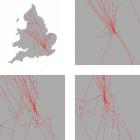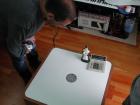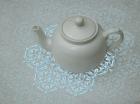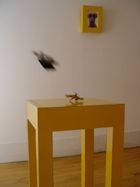Andy Boucher, Sarah Pennington, Jacob Beaver, Bill Gaver ‘When we first plugged in the Drift Table, the little round window in the middle
showed our home from the air. We’d never seen this view of it before, and sat around
staring. But then we started treating it more like a regular coffee table – you
know, letting stuff pile up on it. That’s how we wandered northwest into Wales and
spotted a good place to go camping. After an evening out, we often bring people
back for a bit of sightseeing. Sometimes though, when I’m on my own, I just end
up daydreaming with it. I couldn’t tell you where I go.’
Julie Harding, Harrow
Visions of the future home are all around us. We see them in sci-fi movies, in
TV commercials, on billboards, in endless glossy magazines. Yet, despite half a
century of hype about the ‘ideal home’, these technological utopias still exist
only in laboratories and commercial exhibitions – and for good reason.
Our belief is that such visions reflect technological possibilities rather than the actualities of life in our ever-evolving homes. At home, we toy with ideas. We indulge our curiosity. We drift into reverie. Could technology help us pursue these exploratory, playful activities as well as assisting with the housework and providing home entertainment?
To develop our ideas about domestic digital technologies we pursued a study of people at home. We gave packs of materials – Domestic Probes – to volunteers from the greater London area [1]. Probe materials included cameras with requests for pictures, a glass for listening to sounds around the house, a device for recording a vivid dream. The probes were designed to encourage our volunteers to respond in subjective, playful ways, and their responses painted a diverse picture of lives at home. Idiosyncratic and surprising, people rarely told us about their work at home, but rather about their passions, diversions and aspirations.
In response to this, we wanted to create designs as resources that people could explore to find their own meaningful uses. Therefore, to develop our ideas for the ‘curious’ home we asked ourselves three main questions:
How ‘connected’ should our homes be?
Many hopes for domestic technologies rest on extending the home through network connectivity, but how much of this do we actually need? The more ‘wiring’ you have, the more information you are forced to absorb. Instead of overlaying the home with an endless quantity of new data, we prefer to introduce small windows on the outside world. We try to highlight local landscapes, and even point out things that are right under your nose. When it comes to electronic data, we feel that moderation rather than abundance makes for a richer, more exciting life.
How ‘smart’ should our homes be?
We are skeptical, and even afraid of, creating an omniscient system for the home. Instead we like to think about technological systems that ‘know just enough’. ‘Shy sensing’ permits devices to track the bare minimum of activity – just enough for the devices to form hypotheses about human behaviour, which may or may not be true. People cannot rely on the system. Instead, they have to work with it. They have to interpret ambiguities by using their imaginations. In the process, they bring meaning to their own lives, in their own way. We hope that this will enrich people’s perceptions both about themselves and about the uses of new technologies.
What should home technologies look like?
In terms of aesthetics (of form and behaviour), our aim is to extend the conceptual and functional range of domestic artefacts by making them more sympathetic to the home environment. We want to develop designs that resist the ‘efficient’ aesthetic of the laboratory or office – that resist it fundamentally, avoiding the pitfalls of spurious ‘styling’. In short, we want to make technology that is truly for the home.
To embody our research perspective, we have designed and built three pieces of electronic furniture for the curious home: the Drift Table, the History Tablecloth and the Key Table.
The Drift Table allows people to float over the British landscape from the comfort of their own home. The weight of objects on the coffee table controls the slow scroll of aerial photographs displayed on a central view-port. Adding weight causes the table both to accelerate and to descend towards the landscape below. But progress is always slow – travelling from London to Devon may take days. So what do you do with it? You do with it as you wish. The Drift Table is not designed to solve problems, but to provide a resource in the home. You might use it to take journeys, or to revisit favourite holiday destinations. You might explore particular questions about geography or town planning. You might even just lose yourself and watch the world go by [2].
The History Tablecloth is designed to cover a kitchen or dining-room table. When objects are left on the table, the cloth starts to glow beneath them, creating a halo that slowly expands. When items are removed, the glow fades. By signalling how long things have been left on it, the History Tablecloth highlights the flow of objects over surfaces in the home. People might be reminded to tidy up more often, or become reluctant to move things lest they disrupt the patterns they form. The Tablecloth’s activity can also be replayed – people might want to relive a recent dinner party, or look for hints about what happened while they were away. However, the Tablecloth does not dictate people’s reactions. It simply provides a set of facts for the user to interpret.
The Key Table guesses at people’s emotional state by sensing the force with which they deposit things on it when they get home. That is, it seeks to read meaning into the simple act of setting down objects – your keys, wallet, mobile phone – and thereby attempts to distinguish between a hard day at the office and a peaceful stroll. A mechanised picture frame signals the Key Table’s mood estimations. Emotional entrances cause the frame to swing out of kilter, warning other household inhabitants to tread carefully. Of course, it could be wrong. People might even pick up and replace objects to convey just the right mood. But by emphasising the importance of emotional communication in the home, the Key Table raises awareness of the issue and encourages people to reflect on their use of objects and spaces to express mood.
Volunteers have lived with the pieces in their homes for periods of two to six weeks, and we are collecting their stories of life with the electronic furniture. We have used a variety of approaches to capture and understand their experiences – from ethnography to documentary making – gathering interpretations that are more ambiguous than evaluative. Because the designs hold back from embodying a definite narrative of use, they aren’t complete until people use them. When people live with them, make sense of them, and find ways to use them, designs like our furniture exist as potentials, not products.
A version of this text appears in the exhibition publication Wonderful: Visions of the Near Future edited by Maria Fusco.
Equator is six-year interdisciplinary research collaboration funded by the Engineering and Physical Science Research Council (EPSRC). The Equator team in the Interaction Design Research Studio at the Royal College of Art leads a project designing new technologies for the home. The RCA team are Bill Gaver, Andy Boucher, Andy Law and Sarah Pennington. Jacob Beaver is a writer.
| 






